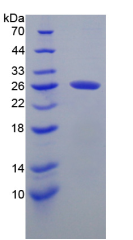Active Chitinase-3-like Protein 1 (CHI3L1)
GP39; CHI3-L1; YKL40; Chondrex; Chitinase 3-Like 1; Chondrocyte Protein YKL40; 39 kDa synovial protein
- Product No.APB463Hu01
- Organism SpeciesHomo sapiens (Human) Same name, Different species.
- Buffer Formulation20mM Tris, 150mM NaCl, pH8.0, containing 1mM EDTA, 1mM DTT, 0.01% SKL, 5% Trehalose and Proclin300.
- Traits Freeze-dried powder
- Purity> 97%
- Isoelectric Point9.4
- ApplicationsCell culture; Activity Assays.
- DownloadInstruction Manual
- UOM 10µg50µg 200µg 1mg 5mg
- FOB
US$ 300
US$ 749
US$ 1498
US$ 4494
US$ 11235
For more details, please contact local distributors!
ACTIVITY TEST

Figure. Cell proliferation of Raji cells after stimulated with GP39.

Figure. Cell proliferation of Raji cells after stimulated with GP39.
Glycoprotein 39, Cartilage (GP39) also known as Chitinase-3-like protein 1 (CHI3L1) is a secreted glycoprotein that is approximately 40kDa in size that in humans is encoded by the CHI3L1 gene. GP39 plays a role in cancer cell proliferation, survival, invasiveness and in the regulation of cell-matrix interactions. To test the effect of GP39 on cell proliferation, Raji cells were seeded into triplicate wells of 96-well plates at a density of 5,000 cells/well with 1% serum standard 1640 which contains various concentrations of recombinant human GP39. After incubated for 5 days, cells were observed by inverted microscope and cell proliferation was measured by Cell Counting Kit-8 (CCK-8). Briefly, 10µL of CCK-8 solution was added to each well of the plate, then the absorbance at 450nm was measured using a microplate reader after incubating the plate for 1-4 hours at 37℃. Proliferation of Raji cells after incubation with GP39 for 5 days observed by inverted microscope was shown in Figure 1. Cell viability was assessed by CCK-8 (Cell Counting Kit-8 ) assay after incubation with recombinant GP39 for 5 days. The result was shown in Figure 2. It was obvious that GP39 significantly increased cell viability of Raji cells.
(A) Raji cells cultured in 1640, stimulated with 10ng/mL GP39 for 5 days;
(B) Unstimulated Raji cells cultured in 1640 for 5 days.
USAGE
Reconstitute in 20mM Tris, 150mM NaCl (pH8.0) to a concentration of 0.1-1.0 mg/mL. Do not vortex.
STORAGE
Avoid repeated freeze/thaw cycles. Store at 2-8°C for one month. Aliquot and store at -80°C for 12 months.
STABILITY
The thermal stability is described by the loss rate. The loss rate was determined by accelerated thermal degradation test, that is, incubate the protein at 37°C for 48h, and no obvious degradation and precipitation were observed. The loss rate is less than 5% within the expiration date under appropriate storage condition.
GIVEAWAYS
INCREMENT SERVICES
-
 BCA Protein Quantification Kit
BCA Protein Quantification Kit
-
 Molecular Mass Marker for Protein
Molecular Mass Marker for Protein
-
 Monoclonal Antibody Customized Service
Monoclonal Antibody Customized Service
-
 Polyclonal Antibody Customized Service
Polyclonal Antibody Customized Service
-
 Protein Activity Test Experiment Service
Protein Activity Test Experiment Service
-
 Electrophoretic Mobility Shift Assay (EMSA) Experiment Service
Electrophoretic Mobility Shift Assay (EMSA) Experiment Service
-
 Buffer
Buffer
-
 Lentivirus Packaging Experiment Service
Lentivirus Packaging Experiment Service
-
 Adenovirus Packaging Experiment Service
Adenovirus Packaging Experiment Service
-
 Real Time PCR Experimental Service
Real Time PCR Experimental Service
-
 Spike RBD Protein (S-RBD)
Spike RBD Protein (S-RBD)
-
 Protein G
Protein G
-
 Protein A
Protein A
| Magazine | Citations |
| Molecular and Cellular Biochemistry | Serum YKL-40: a potential biomarker for psoriasis or endothelial dysfunction in psoriasis? Pubmed:25421412 |
| BMC Pulmonary Medicine | YKL-40 is correlated with FEV1 and the asthma control test (ACT) in asthmatic patients: influence of treatment Pubmed:25578181 |
| International Journal of Rheumatic Diseases | Assessment of pulsed electromagnetic field therapy with Serum YKL‐40 and ultrasonography in patients with knee osteoarthritis PubMed: 25955771 |
| Respiratory Research | YKL-40 expression in chronic obstructive pulmonary disease: relation to acute exacerbations and airway remodeling Pubmed:27013031 |
| United States Patent Application | Compositions and Methods for Diagnosing Lung Cancer y2016:0077095.html |
| Chronic obstructive pulmonary disease (COPD)--from biomarkers to clinical phenotypes ISBN:978-951-51-4039-5 | |
| EYE | YKL-40 is a local marker for inflammation in patients with pseudoexfoliation syndrome Pubmed: 30560917 |
| European Review for Medical and Pharmacological Sciences | Astrocytes induce proliferation of oligodendrocyte progenitor cells via connexin 47-mediated activation of Chi3l1 expression Pubmed: 31002152 |
| International journal of molecular sciences | Differences in Osteoimmunological Biomarkers Predictive of Psoriatic Arthritis among a Large Italian Cohort of Psoriatic Patients Pubmed: 31717649 |
| Research square | Oligodendrocyte Progenitor Cells Increase Chi3l1 Secretion in Exosome to Activate Myh9 and Promote Proliferation through Connexin47 Connected to … |
| International Journal of Chronic Obstructive Pulmonary Disease | High Blood Eosinophil and YKL-40 Levels, as Well as Low CXCL9 Levels, are Associated with Increased Readmission in Patients with Acute Exacerbation of Chronic Obstructive Pulmonary Disease 33814903 |








